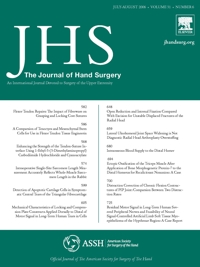
Greater operative time and ROM with titanium plate vs K-wire fixation for phalangeal fractures
J Hand Surg Am. 2019 Dec;44(12):1091.e1-1091.e9.Forty patients with unstable phalangeal fractures were randomized to receive fracture fixation with a Kirschner wire (K-wire) or with titanium plates and screws. The primary outcome of interest was total active motion. Secondary outcomes of interest included time to clinical and radiographic fracture union, pain on a Visual Analog Scale (VAS), grip strength, loss of grip strength relative to the healthy hand, Quick-Disability of the Arm, Shoulder and Hand (DASH) scores, operative time and complications. Results revealed significantly greater total active motion in the titanium plate group compared to the K-wire group. Operative time was longer in the titanium plate group compared to the K-wire group. No significant differences in VAS pain scores, grip strength, loss of grip strength relative to the healthy hand, and Quick-DASH scores were observed between the two groups. Fewer complications were observed in the titanium plate group compared to the K-wire group.
Unlock the full ACE Report
You have access to {0} free articles per month.Click below to unlock and view this {1}
Unlock NowCritical appraisals of the latest, high-impact randomized controlled trials and systematic reviews in orthopaedics
Access to OrthoEvidence podcast content, including collaborations with the Journal of Bone and Joint Surgery, interviews with internationally recognized surgeons, and roundtable discussions on orthopaedic news and topics
Subscription to The Pulse, a twice-weekly evidence-based newsletter designed to help you make better clinical decisions
Exclusive access to original content articles, including in-house systematic reviews, and articles on health research methods and hot orthopaedic topics
Or upgrade today and gain access to all OrthoEvidence content for just $1.99 per week.
Already have an account? Log in


Subscribe to "The Pulse"
Evidence-Based Orthopaedics direct to your inbox.
{0} of {1} free articles
Become an OrthoEvidence Premium Member. Expand your perspective with high-quality evidence.
Upgrade Now












































































